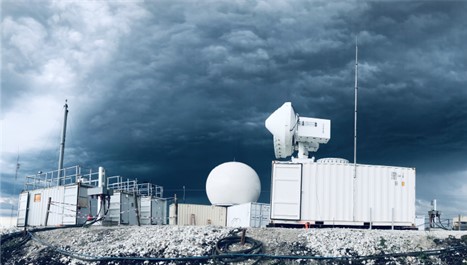Storm width dictates which atmospheric properties control storm depth
Submitter
Fast, Jerome D — Pacific Northwest National Laboratory
Area of research
Cloud Distributions/Characterizations
Journal Reference
Science
Storms are a primary mechanism for transporting atmospheric properties, such as trace gases, aerosols, moisture, heat, and momentum, that significantly impact weather and climate. Where these constituents are transported is modulated by storm depth; therefore, accurate prediction of this parameter affects the subsequent ability to accurately predict weather and climate. Storm depth has remained difficult to predict, with observations showing that storms tend to fall short of their theoretical expected depths. By tracking individual storms and their nearby atmospheric properties, this study shows that the dominant control of how far storms deviate from their theoretical potential is the relative humidity of a layer of air about 12-15,000 feet above sea level. This affects how much the storm’s fuel dilutes due to mixing with surrounding dry air, a process that controls the majority of storm cell depths, with dilution increasing as cells become narrower. When storm cells were sufficiently wide, they were not affected by such dilution and reached their predicted depths based on the fuel available to them.
Impact
This study modified and applied a storm tracking method to field observations to test evidence from computer models that storm width regulates the storm's dilution and depth reached. Not only do the observations support previous modeling studies, but this work found that a model configuration similar to those used for regional weather and climate forecasting can generally reproduce observed storm depth sensitivities based on atmospheric conditions. A substantial portion of storm depth variability remains unexplained and deserves further research, but it is clear from this study that mid-atmosphere humidity coupled with potential energy available to storms and storm width are critical to predicting storm growth.
Summary
Models need to predict convective cloud depths realistically to accurately estimate the amounts of heat, moisture, momentum, trace gases, and aerosols vertically transported by storms, which affects weather and climate predictions. Atmospheric controls on convective cloud depth were investigated with thousands of radar-tracked convective cells tagged with sounding-derived atmospheric parameters from an Atmospheric Radiation Measurement (ARM) user facility field campaign in central Argentina. Convective available potential energy and level of neutral buoyancy are top predictors of wide cell maximum depth, while mid-tropospheric relative humidity is the top predictor of narrow cell maximum depth. A model with 3-km horizontal grid spacing configured similarly to an operational weather forecasting model produces similar results to those observed. Narrow cells become deeper as the mid-troposphere cools and moistens with weaker sinking air, while wide cells become deeper as the lower troposphere warms and moistens. Simulations confirm that differing rates of dilution for narrow and wide cells are the cause of their differing atmospheric sensitivities. Further research should test the representativeness of these conclusions with measurements from other geographical locations and different models. More research is also needed to quantify convective updraft widths and the processes that control them, given their clearly central role in controlling storm growth.


